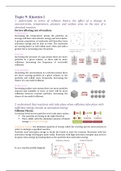Summary
Summary Kinetics I
- Course
- Institution
- Book
Detailed notes on kinetics I. Notes written using Edexcel Chemistry textbooks, past papers and more. Written by a student with all A*s at GCSE, 3A* predictions at A Level and with an offer for Natural Sciences at Cambridge.
[Show more]




